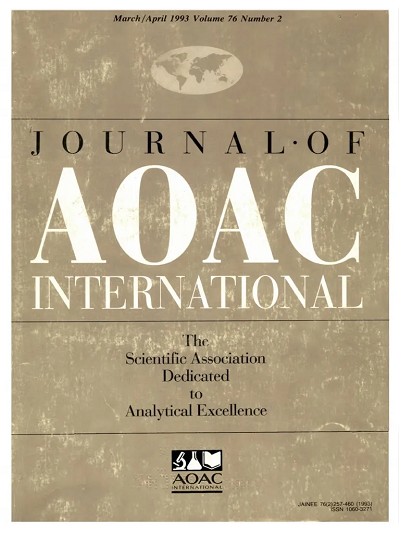Determination of Aloin A, Aloin B, and Aloe-Emodin in Raw Materials and Finished Products Using HPLC Multi-Laboratory Validation Study, AOAC 2016.09, Final Action Status
IF 1.7
4区 农林科学
Q3 CHEMISTRY, ANALYTICAL
引用次数: 0
Abstract
Background A multi-laboratory validation study was performed on AOAC Official Method of Analysis (OMA) 2016.09, for final action. Eight different laboratories throughout the world participated in the study tested the same set of 6 different laboratory samples of raw materials (commercial) and formulated products (commercial), and all the laboratories successfully generated results within the acceptance criteria. Objective The intention of the study was to evaluate specificity, precision (variation), linearity/range, system suitability, limit of detection (LOD), and limit of quantitation (LOQ) by multiple laboratories to satisfy the requirement of moving the OMA 2016.09 to the final action status. Accuracy and ruggedness were already validated in earlier work of single laboratory validation (1), and it was not necessary to include these validation parameters in the multi-laboratory validation study. Method Laboratory samples containing Aloe were sent out to participating laboratories. Each lab followed AOAC 2016.09 (First Action status) to analyze contents of aloin A, aloin B, and aloe emodin using high performance liquid chromatography (HPLC) instrument. The results generated by each laboratory were collected and evaluated. Results The specificity results show that blank and matrix chromatograms do not contain major interfering peaks on the retention time of aloin A, aloin B, and aloe-emodin. The precision (variation) results of duplicated preparations are not more than 0.05 parts per million (ppm) different. The linearity/range results from six standards (10 parts per billion (ppb), 20 ppb, 40 ppb, 80 ppb, 160 ppb, and 500 ppb) have correlation coefficient (R) value of ≥ 0.999. The system suitability results meet the acceptance criteria to show the instrument validity. The limit of detection (LOD) results show that the signal-to-noise (S/N) ratio of 10 ppb standards for all three components are about 3. The limit of quantitation (LOQ) results show that the S/N ratio of 20 ppb standards for all three components are about 10. Conclusions The validation parameters (specificity, precision (variation), linearity/range, system suitability, LOD, and LOQ) have been successfully analyzed, and it shows that the test method is suitable for its intended use. Highlights The test method has been successfully validated by the eight different laboratories around the world (US, UK, Germany, and Canada). Each of the laboratory is managed independently by the site lab management team. This multi-lab study validated the method of Determination of Aloin A, Aloin B, and Aloe-Emodin in Raw Materials and Finished Products Using high performance liquid chromatography (HPLC), and the method fits for its intended purpose.利用 HPLC 多实验室验证研究测定原材料和成品中的芦荟素 A、芦荟素 B 和芦荟大黄素,AOAC 2016.09,最终行动状态
背景 对 AOAC 官方分析方法 (OMA) 2016.09 进行了一项多实验室验证研究,以便最终采取行动。全球有 8 家不同的实验室参与了这项研究,对同一套 6 种不同的原材料(商业)和配方产品(商业)实验室样品进行了测试,所有实验室都成功得出了符合验收标准的结果。目标 该研究旨在评估多个实验室的特异性、精密度(变异)、线性/范围、系统适用性、检测限 (LOD) 和定量限 (LOQ),以满足将 OMA 2016.09 移至最终行动状态的要求。准确度和耐用性已在早期的单实验室验证工作中得到验证 (1),因此没有必要将这些验证参数纳入多实验室验证研究中。方法 实验室含有芦荟的样品被发送到参与实验室。各实验室按照 AOAC 2016.09(首次行动状态)的要求,使用高效液相色谱(HPLC)仪器分析芦荟素 A、芦荟素 B 和芦荟大黄素的含量。收集并评估了各实验室得出的结果。结果 特异性结果表明,空白色谱图和基质色谱图在芦荟苷 A、芦荟苷 B 和芦荟大黄素的保留时间上不包含主要干扰峰。重复制备的样品的精密度(变异)结果相差不超过 0.05 百万分之一(ppm)。六种标准品(10ppb、20ppb、40ppb、80ppb、160ppb 和 500ppb)的线性/范围结果的相关系数(R)≥ 0.999。系统适用性结果符合仪器有效性的验收标准。检测限(LOD)结果表明,10 ppb 标准品检测三种成分的信噪比(S/N)约为 3;定量限(LOQ)结果表明,20 ppb 标准品检测三种成分的信噪比(S/N)约为 10。结论 成功分析了验证参数(特异性、精密度(变异)、线性/范围、系统适用性、LOD 和 LOQ),表明该测试方法适合其预期用途。亮点 该测试方法已成功通过全球八个不同实验室(美国、英国、德国和加拿大)的验证。每个实验室都由现场实验室管理团队独立管理。这项多实验室研究验证了使用高效液相色谱法(HPLC)测定原材料和成品中芦荟素 A、芦荟素 B 和芦荟大黄素的方法,该方法符合预期目的。
本文章由计算机程序翻译,如有差异,请以英文原文为准。
求助全文
约1分钟内获得全文
求助全文
来源期刊

Journal of AOAC International
医学-分析化学
CiteScore
3.10
自引率
12.50%
发文量
144
审稿时长
2.7 months
期刊介绍:
The Journal of AOAC INTERNATIONAL publishes the latest in basic and applied research in analytical sciences related to foods, drugs, agriculture, the environment, and more. The Journal is the method researchers'' forum for exchanging information and keeping informed of new technology and techniques pertinent to regulatory agencies and regulated industries.
 求助内容:
求助内容: 应助结果提醒方式:
应助结果提醒方式:


